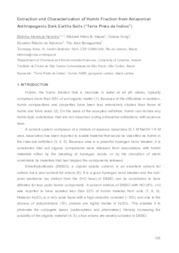Extraction and characterisation of humin fraction from Amazonian anthropogenic dark earth soils ("Terra Preta de Indios").
Extraction and characterisation of humin fraction from Amazonian anthropogenic dark earth soils ("Terra Preta de Indios").
Author(s): NOVOTNY, E. H.; HAYES, M. H. B.; SONG, G.; AZEVEDO, E. R. de; BONAGAMBA, T.
Summary: Humin, the humic fraction that is insoluble in water at all pH values, typically comprises more than 50% of soil organic matter (1). Because of the difficulties in isolation, humin compositions and properties have been less extensively studied than those of humic and fulvic acids (2). On the basis of the accepted definition, humin can include any humic-type substances that are not dissolv ed during exhaustive extractions with aqueous base. A solvent system composed of a mixture of aqueous base/urea (0.1 M NaOH + 6 M urea, base/urea) has been reported to isolate material that would be classified as humin in the classical definition (3, 4, 5). Because urea is a powerful hydrogen bond breaker, it is considered that soil organic components were released from associations with humin materials either by the breaking of hydrogen bonds, or by the disruption of steric constraints by materials that had trapped the components released. Dimethylsulfoxide (DMSO), a dipolar aprotic solvent, is an excellent solvent for cations but a poor solvent for anions (6). It is a good hydrogen bond breaker and the non- polar backbone (as distinct from the S=O face) of DMSO can be considered to have affinities for less polar humin components. A solvent mixture of DMSO with HCl (6%, v/v) was reported to have isolated less than 22% of humin material from soils (7, 8, 9). However H 2SO4 is a very polar liquid with a high dielectric constant (~100), and due to the process of autoprotolysis (10), protons are highly mobile in H 2SO4. This enables it to protonate the conjugate bases (carboxylates and phenolates), thereby increasing the solubility of the organic material (4, 5), since anions are weakly solvated in DMSO.
Publication year: 2008
Types of publication: Paper in annals and proceedings
Unit: Embrapa Soils
Keywords: NMR, black carbon, humin, indios, pyrogenic carbon, terra preta
Observation
Some of Embrapa's publications are published as ePub files. To read them, use or download one of the following free software options to your computer or mobile device. Android: Google Play Books; IOS: iBooks; Windows and Linux: Calibre.
Access other publications
Access the Agricultural Research Database (BDPA) to consult Embrapa's full library collection and records.
Visit Embrapa Bookstore to purchase books and other publications sold by Embrapa.

